Horizontal or Vertical?
Both of today’s featured images were created from the same Nancy Thornblad raw file. Which do you like best, the horizontal or the vertical? Why?
What’s Up?
Tuesday morning dawned sunny and still. I did a pre-dawn silhouette of the eagle nest and was surprised that I did not see the young bird in the nest. I learned later that it had already branched and had been perched about 10 feet above and to the north of the nest when I created the silhouette. Later in the morning, when it clouded over, I was able to make a few nice images of the eaglet. I checked on the two-egg crane nest in the North Marsh and was pleased to see the female sitting peacefully on her eggs. The two-colt crane family was in the marsh, so I passed on them and headed home early to get to work.
Today is Wednesday 16 March 2022. The forecast is calling for overnight thunderstorms, mostly cloudy early, and rain for the rest of the day. I will head down to the lake in a few minutes just because. Wherever you are and whatever you are doing, I hope that you too had a great day. This blog post took a bit more than an hour to prepare and makes seven days in a row with a new one.
Please remember to use the B&H and Amazon links on most blog pages and to use the BIRDSASART discount code at checkout when purchasing your new gear from Bedfords. And please consider joining a BAA IPT. You will be amazed at how much you will learn …
SONY FE 4.5-5.6/70-300mm f2.8 G OSS Lens
Multiple IPT veteran Larry Master is offering a SONY FE 4.5-5.6/70-300mm f2.8 G OSS lens in like-new condition for $599.00. The lens was never used. The sale includes the original product box, the rear lens cap, the lens case, the front lens cover, the lens strap, and insured ground shipping via major courier to lower-48 US addresses only.
Your item will not ship until your check clears unless other arrangements are made.
Please contact Larry via e-mail at lawrencemaster@gmail.com or by phone at 1-518-645-1545 EDT.
This very small, incredibly versatile, lightweight lens will fit all Sony e-Mount mirrorless camera bodies like the a7R III and IV, the a9 and the a9 II, and the Alpha 1. It is also compatible with APS-C sensor bodies like the Sony Alpha a6000 and the a6400. I would make an ideal travel lens as well as a great mid-range telephoto for nature photographers. For bird photographers, it would complement the 200-600 G lens almost perfectly. Best of all? It is priced to sell; a new one would cost you $1273.00. Grab Larry’s lens today and save a handsome $674.00! artie
|
|
|
This image was created on 5 October 2021 on the Fall Fort DeSoto IPT by participant Nancy Thornblad. She used the hand held Canon RF 100-500mm f/4.5-7.1 L IS USM lens at 463mm and the very affordable Canon EOS R6 Mirrorless camera body. The exposure was determined via histogram review.ISO 2000: 1/4000 second at f8 (stopped down 1/3 stop). AWB at 8:18:42am on a partly cloudy morning. Be sure to click on the image to enjoy the high-res version. Photo courtesy of and Copyright 2021: Nancy Thornblad.
|
Pre-IPT Gear Help
Nancy called in mid-September to learn about the 2021 Fall Fort DeSoto IPT. In our follow-up e-mails, we reviewed her current gear. I suggested that she purchase the Canon RF 100–500 lens. She was thrilled that Steve Elkins of Bedfords was able to get one for her in short order. She also mentioned that she could not make any good photos with her Canon R6 and that she preferred her 1DX. We sent her the Canon EOS R5/R6 Camera User’s Guide and she was good to go.
I am always glad to help folks upgrade their gear to best suit their individual needs. And that is true for everyone, not just folks who are signing up for an IPT.
The IPT Experience
Via e-mail from Nancy Thornblad
Hello Artie,
I appreciate all the work you did on the IPT helping me with everything from choosing the right equipment, travel and lodging, getting the right exposure, improving my compositions, and simply creating getting better photographs. The IPT was a wonderful experience, and it was great to learn from such an experienced and knowledgeable photographer. With all the individual attention, I came away from the IPT a better photographer and will continue to use what I learned every time I go out to photograph. Thanks for the ten critiques. I am looking forward to the next time. Thank you for sharing your knowledge with me. Nancy
With fewer folks signing up for IPTs over the past few years (for reasons unbeknownst to me), everyone who attends an IPT will receive a ton of individual instruction both in the field and at the computer.
Today’s Featured Images
Thanks to Nancy for letting me share her preening Marbled Godwit image here today. Image #1 is a small crop from the horizontal original, and Image #2 is a vertical crop from that. The R6 image held up well to the cropping.
|
|
|
This is the same image cropped to a vertical. As above, it was created on 5 October 2021 on the Fall Fort DeSoto IPT by participant Nancy Thornblad. She used the hand held Canon RF 100-500mm f/4.5-7.1 L IS USM lens at 463mm and the very affordable Canon EOS R6 Mirrorless camera body. The exposure was determined via histogram review. ISO 2000: 1/4000 second at f8 (stopped down 1/3 stop). AWB at 8:18:42am on a partly cloudy morning. Be sure to click on the image to enjoy the high-res version. Photo courtesy of and Copyright 2021: Nancy Thornblad.
|
Don’t Take This Lightly
Many photo tour leaders are more than glad to get rid of their group at lunch. Each promotion of a BAA IPT includes this:
There will be a Photoshop/image review session after lunch (included) each day.
These sessions are hugely popular. On Day One I will usually pick my keepers from the morning session while explaining the fine differences that make one or two images the best from 5 to 30 frame bursts of the same subject/situation. That is almost always followed by an image optimization or two. Those are recorded and a link to the video is sent to the group.
On the following days, we will look at participants’ images. I will pick a strong one to optimize from the raw conversion to the JPEG creation. And again, the whole process is recorded and a link to the video sent to the group.
These sessions are amazingly valuable, not only for the group but for me as well. Why the latter? Many of my best Photoshop tricks and techniques are a result of someone saying, “Why are you doing it that way? There is a much easier way to do it.”
|
|
|
Fort DeSoto in spring is rife with tame birds, many in full breeding plumage. Click on the composite to enjoy a larger version. Clockwise from upper left around to center: Laughing Gull landing on head of Brown Pelican, Laughing Gull in flight, Reddish Egret sunrise silhouette, Great Blue Heron with needlefish, Yellow-crowned Night Heron with ghost crab, Roseate Spoonbill, Sanderling in breeding plumage, and white morph Reddish Egret in glorious breeding plumage. |
The 2022 DeSoto Spring IPT/April 26 through the morning session on April 29, 2020. 3 1/2 DAYS: $2099.00. Limit: 6 photographers/Openings 4
Fort DeSoto, located just south of St. Petersburg, FL, is a mecca for breeding terns and gulls and wading birds in spring. Migrant shorebirds are in abundance, and many are exceedingly tame. We should have great chances on Royal and Sandwich Terns and both white- and dark-morph Reddish Egrets. Great Egret, Snowy Egret, Great Blue Heron, Tricolored Heron, and White Ibis are easy as well and we will almost surely come up with a tame Yellow-crowned Night-Heron or two along with some American Oystercatchers. We will enjoy lots of great flight photography.
|
|
|
Again, Fort DeSoto in spring is rife with tame birds, most in breeding plumage. Click on the composite to enjoy a larger version. Clockwise from upper left around to center: Laughing Gull in flight, Yellow-crowned Night-Heron, Sandwich Terns copulating, Roseate Spoonbill, Great Egret with reflection, breeding plumage Short-billed Dowitcher, American Oystercatcher, Royal Tern, white morph Reddish Egret, and Snowy Egret in marsh. |
We will also get to photograph a variety of other shorebirds including Black-bellied, Semipalmated, Wilson’s, and Piping Plovers, Willet, Dunlin, Short-billed Dowitcher, most especially, Red Knot with many individuals in their handsome breeding plumages. In spring the T-shaped peninsula and the newly formed sandbar, Outback Key, are literally packed with avian treasures. With any luck, we might get to photograph one of Florida’s most desirable species: Roseate Spoonbill. And we will almost surely get to do some Brown Pelican flight photography. With luck, they will have Laughing Gulls landing on their heads. And though not guaranteed, Wood Stork might well be expected. And we will be on the lookout for a migrant passerine fallout in the event of a thunderstorm or two.
|
|
|
Yes, Fort DeSoto in spring is rife with tame birds, most in breeding plumage. Click on the composite to enjoy a larger version. Clockwise from upper left around to center: breeding plumage Dunlin, dark morph Reddish Egret displaying, Laughing Gull vertical front-end portrait, Laughing Gull with prey item, landing on head of Brown Pelican, breeding plumage Royal Tern displaying, Royal Terns — pre-copulatory stance, Laughing Gulls copulating, Laughing Gull head portrait, breeding plumage Sandwich Tern with fish, and a rare treat, a breeding plumage White-rumped Sandpiper. |
On the IPT you will learn:
- 1- The basics and fine points of digital exposure; how to get the right exposure every time after making a single test exposure (or before if you are using SONY gear).
- 2- How and why to work in Manual mode (even if you’re scared of it).
- 3- How to approach free and wild birds without disturbing them.
- 4- Lots about bird behavior and how to use that knowledge to help you create better images.
- 5- To age and identify many species of shorebirds including sandpipers, plovers, dowitchers, and possibly yellowlegs.
- 6- To spot good situations and to choose the best perspective.
- 7- To see, evaluate, and understand the light.
- 8- To design pleasing images by mastering your camera’s AF system.
- 9- And perhaps most importantly, to evaluate wind and sky conditions and understand how they affect bird photography.
- 10- How and when to access the magical sandbar safely.
- 11- More than you could ever imagine.
|
|
|
You got it by now! Fort DeSoto in spring is rife with tame birds, most in breeding plumage. Click on the composite to enjoy a larger version. Clockwise from upper left around to center: Roseate Spoonbill, immature Brown Pelican in flight, the heron/egret hybrid, American Oystercatcher feeding, immature Royal Tern on railing, Great Egret morning silhouette, Black Skimmer in surf, and underside head portrait of Great Blue Heron. |
Morning sessions will run at least three hours, afternoon sessions 2 1/2. There is never a set schedule on an IPT — we adapt to the conditions. On cloudy mornings when the photography is excellent, we may opt to extend the morning session and skip the afternoon, especially if the afternoon weather is not looking too good. There will be a Photoshop/image review session after lunch (included) each day. That will be followed by Instructor Nap Time. This IPT will run with only a single registrant (though that is not likely to happen). The best airport is Tampa (TPA). Once you register, you will receive an e-mail with lodging information. Do know that it is always best if IPT folks stay in the same general area — Gulfport in this case, rather than at home or at a friend’s place a good distance away.
Folks attending this IPT will be out in the field early and stay late to take advantage of sunrise and sunset colors; this is pretty much a staple on almost all BIRDS AS ART Instructional Photo-Tours. Doing so will often present unique photographic opportunities, opportunities that will be missed by those who need their beauty rest and those who need to get home for a proper dinner. I really love it when I am leaving the beach at 9:30am on a sunny morning after a great session just as a carful or two of well-rested photographers are arriving … We will be getting wet.
Credit cards are OK for your $500 deposit. You can register by calling Jim or Jennifer during weekday business hours at 863-692-0906 with a credit card in hand. After you leave the deposit, you will receive an e-mail with your balance statement and instructions for sending your balance check. If you wish to pay in full right off the bat, you can make your check out to BIRDS AS ART and send it via US mail here: BIRDS AS ART, PO BOX 7245, Indian Lake Estates, FL 33855. You will receive a confirmation e-mail with detailed instructions, and clothing and gear advice a month before the trip. Please shoot me an e-mail if you plan to register or if you have any questions.
Typos
With all blog posts, feel free to e-mail or to leave a comment regarding any typos or errors.

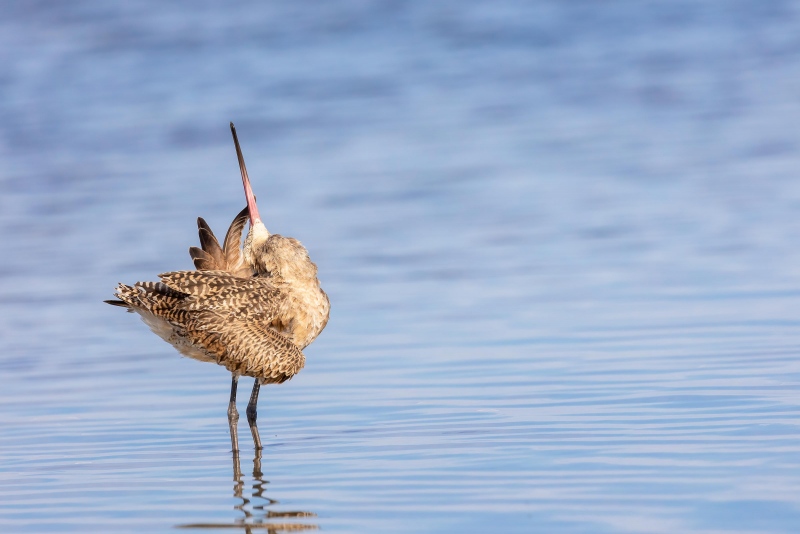
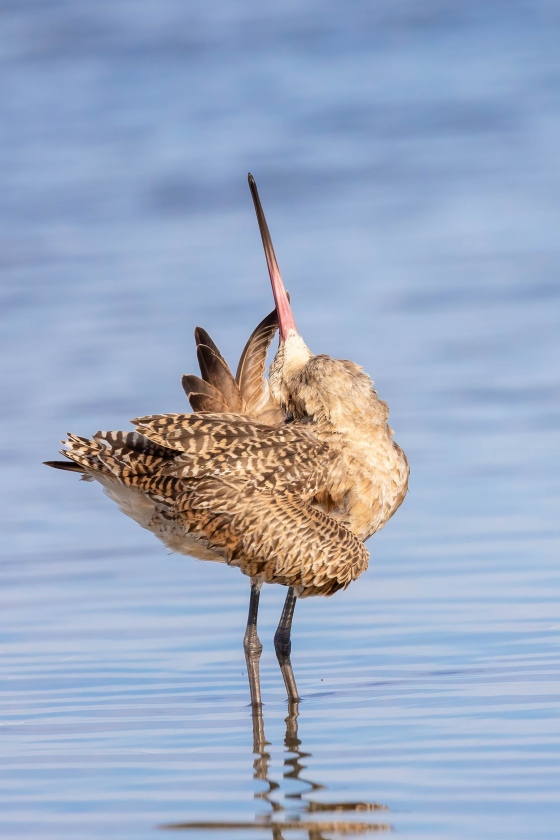
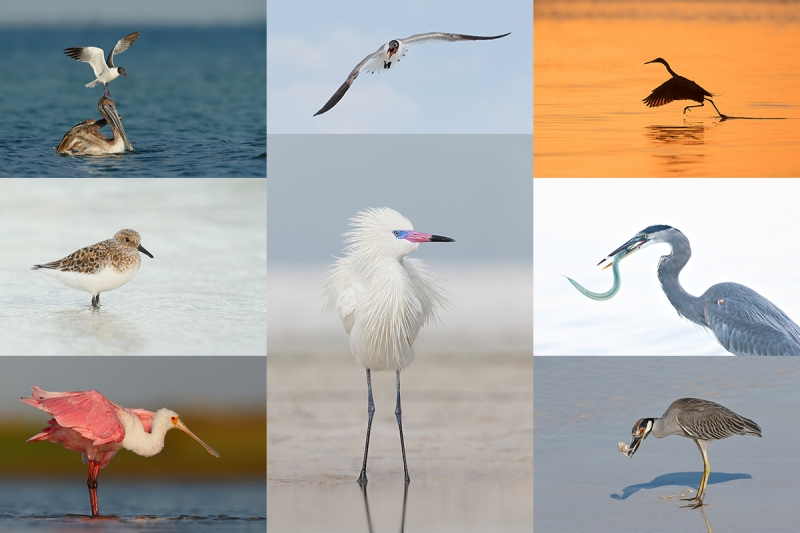
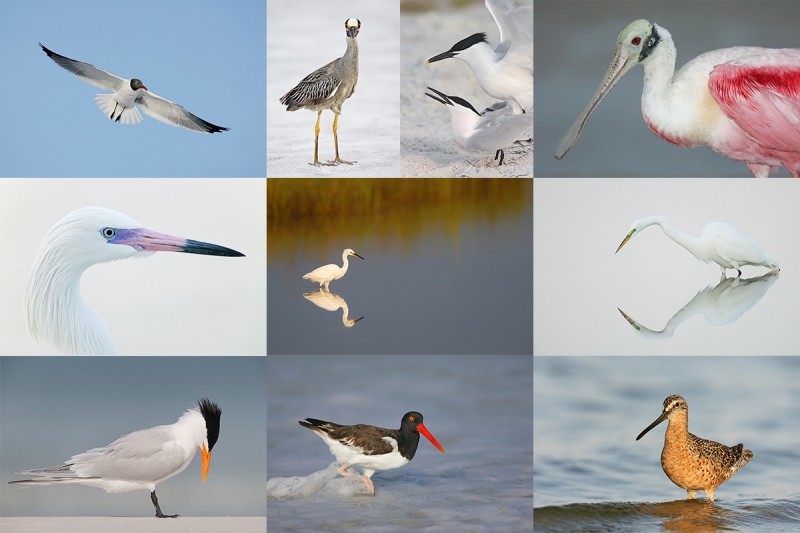
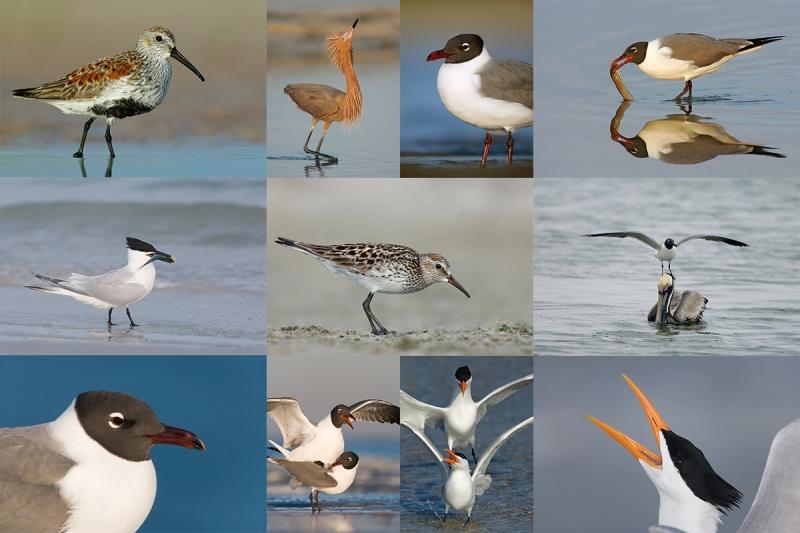
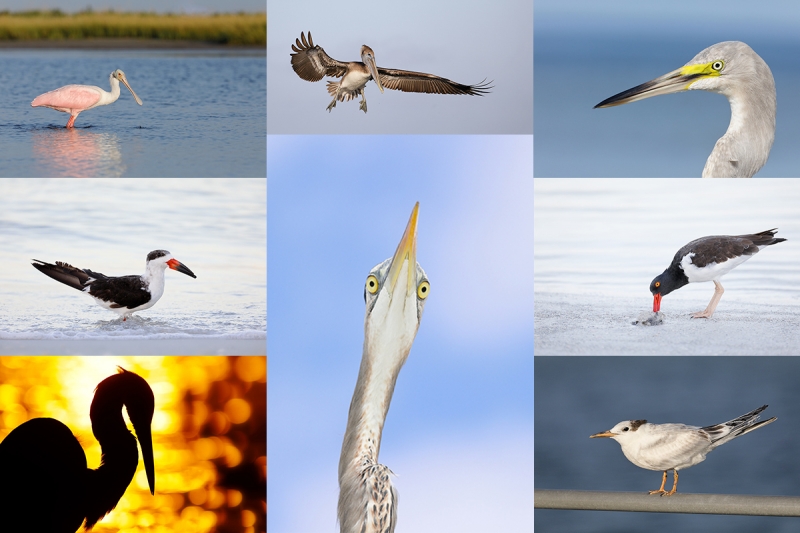













No. 2 is my favorite. The pose of the bird leads itself to the vertical orientation. I like the composition and the way the feather curls around to the bill. Very nice. Thanks for sharing.
Image #1 is my favourite, I love the composition and I like the feeling of the more room around the bird.
I prefer #2. I don’t see anything in the bird’s pose that calls for all the room on the right that the horizontal crop provides. It’s not going or pointing to the right.
#2 is my favorite although both are excellent. In 2, the vertical bill and chest, three vertical feathers and legs all shout out for a vertical composition.